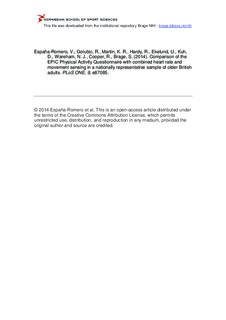| dc.contributor.author | España-Romero, Vanesa | |
| dc.contributor.author | Golubic, Rajna | |
| dc.contributor.author | Martin, Kathryn R. | |
| dc.contributor.author | Hardy, Rebecca | |
| dc.contributor.author | Ekelund, Ulf | |
| dc.contributor.author | Kuh, Diana | |
| dc.contributor.author | Wareham, Nicholas J. | |
| dc.contributor.author | Cooper, Rachel | |
| dc.contributor.author | Brage, Søren | |
| dc.date.accessioned | 2015-06-01T12:26:07Z | |
| dc.date.available | 2015-06-01T12:26:07Z | |
| dc.date.issued | 2014-02-06 | |
| dc.identifier.citation | PLoS ONE. 2014, 9, e87085 | nb_NO |
| dc.identifier.uri | http://hdl.handle.net/11250/284359 | |
| dc.description | © 2014 España-Romero et al. | nb_NO |
| dc.description.abstract | Objectives: To compare physical activity (PA) subcomponents from EPIC Physical Activity Questionnaire (EPAQ2) and combined heart rate and movement sensing in older adults.
Methods: Participants aged 60–64y from the MRC National Survey of Health and Development in Great Britain completed EPAQ2, which assesses self-report PA in 4 domains (leisure time, occupation, transportation and domestic life) during the past year and wore a combined sensor for 5 consecutive days. Estimates of PA energy expenditure (PAEE), sedentary behaviour, light (LPA) and moderate-to-vigorous PA (MVPA) were obtained from EPAQ2 and combined sensing and compared. Complete data were available in 1689 participants (52% women).
Results: EPAQ2 estimates of PAEE and MVPA were higher than objective estimates and sedentary time and LPA estimates were lower [bias (95% limits of agreement) in men and women were 32.3 (−61.5 to 122.6) and 29.0 (−39.2 to 94.6) kJ/kg/day for PAEE; −4.6 (−10.6 to 1.3) and −6.0 (−10.9 to −1.0) h/day for sedentary time; −171.8 (−454.5 to 110.8) and −60.4 (−367.5 to 246.6) min/day for LPA; 91.1 (−159.5 to 341.8) and 55.4 (−117.2 to 228.0) min/day for MVPA]. There were significant positive correlations between all self-reported and objectively assessed PA subcomponents (rho = 0.12 to 0.36); the strongest were observed for MVPA (rho = 0.30 men; rho = 0.36 women) and PAEE (rho = 0.26 men; rho = 0.25 women).
Conclusion: EPAQ2 produces higher estimates of PAEE and MVPA and lower estimates of sedentary and LPA than objective assessment. However, both methodologies rank individuals similarly, suggesting that EPAQ2 may be used in etiological studies in this population. | nb_NO |
| dc.language.iso | eng | nb_NO |
| dc.publisher | PLOS.org | nb_NO |
| dc.subject | sleep | nb_NO |
| dc.subject | bioenergetics | nb_NO |
| dc.subject | employment | nb_NO |
| dc.subject | questionnaires | nb_NO |
| dc.subject | body mass index | nb_NO |
| dc.subject | elderly | nb_NO |
| dc.subject | heart rate | nb_NO |
| dc.subject | obesity | nb_NO |
| dc.title | Comparison of the EPIC physical activity questionnaire with combined heart rate and movement sensing in a nationally representative sample of older British adults | nb_NO |
| dc.type | Journal article | nb_NO |
| dc.type | Peer reviewed | nb_NO |
| dc.subject.nsi | VDP::Mathematics and natural science: 400::Basic biosciences: 470 | nb_NO |
| dc.subject.nsi | VDP::Agriculture and fishery disciplines: 900::Agriculture disciplines: 910 | nb_NO |
| dc.source.journal | PLoS ONE | nb_NO |
| dc.description.localcode | Seksjon for idretssmedisinske fag / Department of Sports Medicine | nb_NO |
